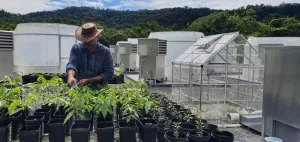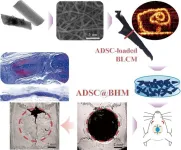(Press-News.org) Ozone gas is reducing the growth of tropical forests – leaving an estimated 290 million tonnes of carbon uncaptured each year, new research shows.
The ozone layer in the stratosphere shields our planet from harmful ultraviolet radiation – and protecting it is one of the major successes of environmental action.
But ozone at ground level – formed by the combination of pollutants from human activities in the presence of sunlight – interferes with plants’ ability to absorb carbon dioxide. Ozone is also harmful to human health.
The new study, published in the journal Nature Geoscience, calculates that ground-level ozone reduces new yearly growth in tropical forests by 5.1% on average.
The effect is stronger in some regions – with Asia’s tropical forests losing 10.9% of new growth.
Tropical forests are vital “carbon sinks” – capturing and storing carbon dioxide that would otherwise stay in the atmosphere and contribute to global warming.
“Tropical forests play a crucial role in mopping up our carbon dioxide emissions,” said co-lead author Dr Alexander Cheesman, of James Cook University and the University of Exeter.
“Our study shows that air pollution can jeopardise this critical ecosystem service.
“We estimate that ozone has prevented the capture of 290 million tonnes of carbon per year since 2000. The resulting cumulative loss equates to a 17% reduction in carbon removal by tropical forests so far this century.”
The researchers ran experiments to measure the ozone susceptibility of various tropical tree species, then incorporated the results into a computer model of global vegetation.
Urbanisation, industrialisation, burning fossil fuels and fires have led to an increase in “precursor” molecules – such as nitrogen oxides – that form ozone.
“Ozone concentrations across the tropics are projected to rise further due to increased precursor emissions and altered atmospheric chemistry in a warming world,” said co-lead author Dr Flossie Brown, a recent graduate of the University of Exeter.
“We found that areas of current and future forest restoration – areas critical for the mitigation of climate change – are disproportionately affected by this elevated ozone.
“It is clear that air quality will continue to play an important but often overlooked part in the way forests absorb and store carbon.”
Professor Stephen Sitch, from the University of Exeter, added: “Embracing a future with greater environmental protection would lead to reduced ground-level ozone, thus improved air quality and the additional benefit of enhanced carbon uptake in tropical forests.”
The paper is entitled: “Reduced productivity and carbon drawdown of tropical forests from ground-level ozone exposure.”
END
Ozone pollution reduces tropical forest growth
2024-09-12
ELSE PRESS RELEASES FROM THIS DATE:
Study finds doctors and patients interested in environmental impact of health care decisions
2024-09-12
BOSTON – Concerns about the environmental impact of healthcare decisions rarely enter into conversations between patients and physicians. However, evidence from a new study led by researchers at Dana-Farber Cancer Institute, shows there's broad interest in changing that.
In a series of focus groups conducted in different areas of the United States, doctors and patients expressed openness to considering environmental factors when discussing treatment options. The findings, presented in a paper published online today by Nature Climate Change, suggest that educating physicians about the environmental costs of treatment ...
Five key factors predict the response of cancer patients to immunotherapy
2024-09-12
Barcelona, 12 September 2024 – Immunotherapy has transformed cancer treatment in recent years by enabling the immune system to attack tumour cells. However, only 20-40% of patients respond positively to immunotherapy, and these rates vary across different types of cancer. Predicting which patients will respond to immunotherapy and which will not is currently a highly active area of research. Numerous studies conducted so far have focused on the specific characteristics of tumours, their microenvironment, or the patient's immune ...
Trilobite fossils from upstate New York reveal “extra” set of legs
2024-09-12
A new study finds that a trilobite species with exceptionally well-preserved fossils from upstate New York has an additional set of legs underneath its head. The research, led by the American Museum of Natural History and Nanjing University in China, suggests that having a fifth pair of head appendages might be more widespread among trilobites than once thought. Published today in the journal Palaeontology, the study helps researchers better understand how trilobite heads are segmented.
Trilobites are ...
Big algebras: A dictionary of abstract math
2024-09-12
Several fields of mathematics have developed in total isolation, using their own ‘undecipherable’ coded languages. In a new study published in PNAS, Tamás Hausel, professor of mathematics at the Institute of Science and Technology Austria (ISTA), presents “big algebras,” a two-way mathematical ‘dictionary’ between symmetry, algebra, and geometry, that could strengthen the connection between the distant worlds of quantum physics and number theory.
Technical Toolkit: Symmetry and commutativity, from esthetics to functionality
Symmetry is not just a question of esthetics and equilibrium, but also a highly recurrent feature throughout the domains ...
BMI’s relation to cancer therapy mortality risks not so straightforward
2024-09-12
While being overweight increases the risk of developing lifestyle-related diseases, there is a phenomenon known as the obesity paradox where a decreased risk of death has been seen during cancer therapy. However, that paradox might not be the trend for all cancer therapies, an Osaka Metropolitan University team reports in JAMA Network Open, a publication of the American Medical Association.
Led by graduate student Mr. Yasutaka Ihara and Professor Ayumi Shintani of the Graduate School of Medicine’s Department of Medical Statistics, ...
Kids in families with too much screen time struggle with language skills
2024-09-12
Screens have become ubiquitous in our daily lives — which means they’ve also become part of children’s lives too. So what effect does this have on children’s developing brains, especially critical language skills? To understand this, scientists in Estonia surveyed the parents of more than 400 children about their screen use, their children’s screen use, and their children’s language skills. They found that parents who use screens a lot also have children who use screens a lot, and that children’s higher screen time is associated with poorer language skills.
“Our ...
Medical College of Georgia scientists searching for new treatment target for diabetic retinopathy
2024-09-12
Scientists at the Medical College of Georgia at Augusta University are searching for a new treatment target for a common complication of diabetes that can cause retinal blood vessels to break down, leak, or become blocked.
Diabetic retinopathy is a serious eye disease and a leading cause of blindness that results when diabetes’ sustained high blood sugar levels cause damage to the retina – the part of the eye that detects light – over time. That can happen in a number of ways, from inflammation to overgrowth ...
High doses of some prescription stimulants tied to increased psychosis risk
2024-09-12
Prescribing rates for stimulants that treat attention-deficit/hyperactivity disorder (ADHD) have increased significantly over the past decade, with some of the largest increases reported during the COVID-19 pandemic. A new study of adult emergency department admissions at Mass General Brigham, led by McLean Hospital researchers, found that individuals who are taking high doses of amphetamine (e.g. Adderall) face more than a five-fold increased risk for developing psychosis or mania. Findings were published September 12th in the American Journal of Psychiatry.
Overall, individuals with past-month prescription amphetamine use had a greater likelihood of new-onset psychosis or mania ...
New national survey shows hesitancy about vaccines this fall
2024-09-12
With flu season just around the corner and COVID-19 cases on the rise, a new nationwide survey from The Ohio State University Wexner Medical Center reveals hesitancy around vaccines this fall. The new data comes just as this year’s flu shot rolls out and following the FDA’s approval of an updated round of COVID-19 vaccines.
The national poll of 1,006 people found more than one-third (37%) have gotten vaccines in the past but do not plan to this year. The same percent of respondents said they don’t need any of the vaccines surveyed in the poll, including flu, COVID-19, pneumococcal and respiratory ...
Revolutionary tubular scaffolds boost stem cell-driven bone regeneration in skull defects
2024-09-12
Scientists from Sun Yat-sen University's School of Biomedical Engineering have developed groundbreaking tubular scaffolds made from electrospun membranes, which significantly enhance bone regeneration in critical skull defects. These scaffolds, designed to mimic natural bone structures, create an ideal environment for adipose-derived stem cells (rADSCs) to thrive and accelerate healing. By integrating advanced materials like polycaprolactone, PLGA, and nano-hydroxyapatite, the researchers achieved remarkable results in both lab and animal studies, ...







